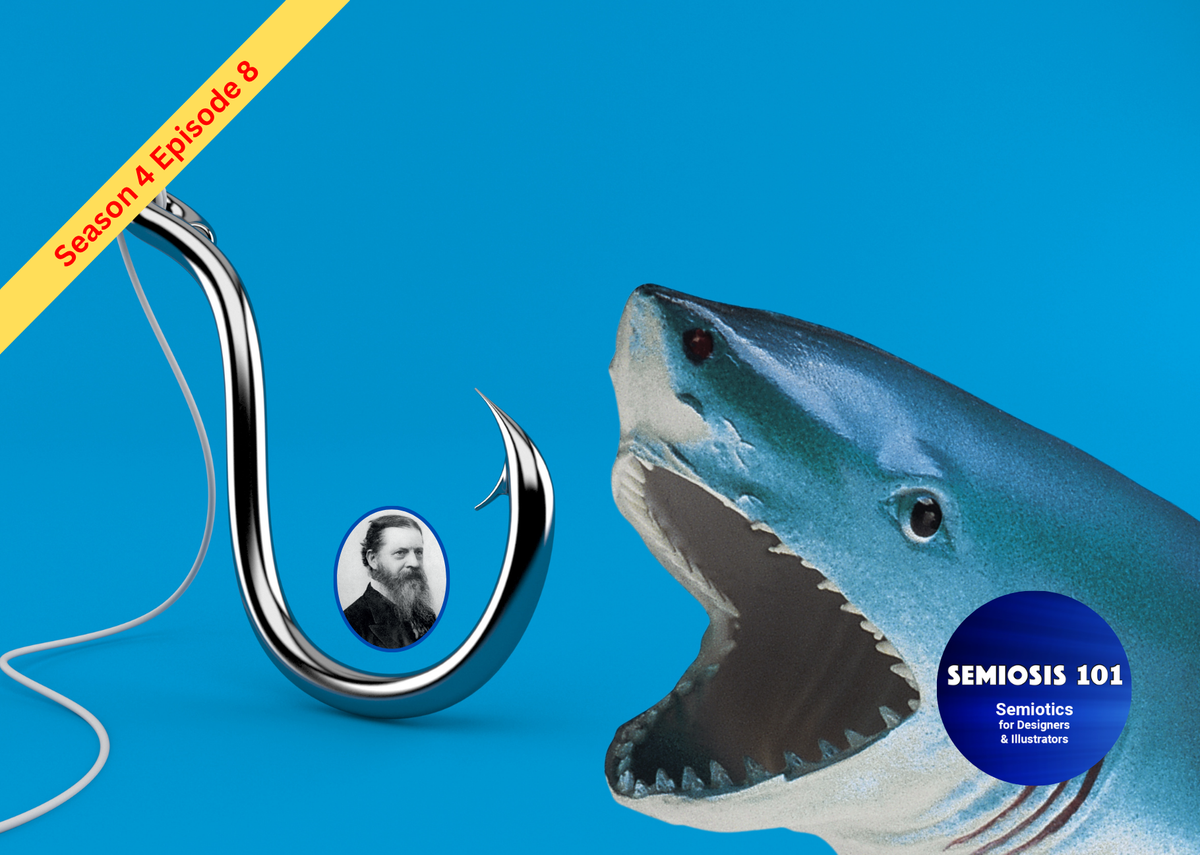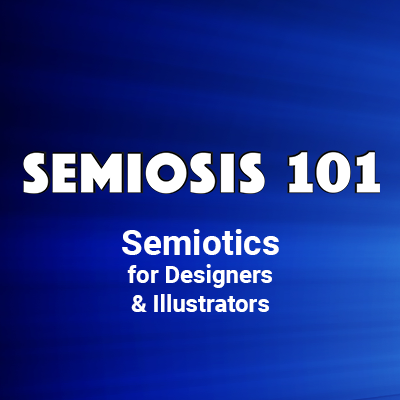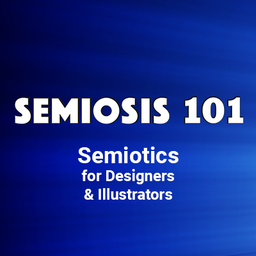Free Semiosis 101 Transcript 4.8:

How Do CREATIVES Hook More Audience Awareness?
Hello readers.
In this free transcript for the episode 4.8 published on Semiosis 101 on Weds 6th August 2025, we focus on how your visual language can semiotically facilitate effective visual communication.
What we design or illustrate is not passive. We visually facilitate actions and reactions, both subconsciously, consciously and physically. Your audience is not passive in this, as the visual language you use in your designs or illustrations facilitates some reaction.
Semiotic sign-action (Semiosis) is powered by mindfully crafting for Perception, Communication and Delivery. You illustrators and designers can semiotically facilitate your audiences’ visual engagement…
Watch the free episode on YouTube for the full impact…
…and here is the episode’s transcript.
How Do CREATIVES Hook More Audience Awareness?
You illustrators and designers can semiotically facilitate your audiences’ visual engagement. Initially. You will also need to retain your audience’s engagement. An awareness of a brand’s identity needs consistent audience engagement, between 5 and 7 times to be remembered and understood. For semiotically-encoded meaning to flow from retained attention, we will now focus on applying semiotic sign-action for audience reaction.
“I just design or illustrate. What is all this talk about action and reaction?”
…some of you may be shouting at me.
I am an advocate for the position taken by design Professor Jorge Frascara, that Visual Communication Design is ultimately the facilitation of behavioural change.
“What now?”
“Action, reaction and now behavioural change facilitation?”
In this 8th episode of Semiosis 101’s season four, what am I on about now? What we design or illustrate is not passive. We visually facilitate actions and reactions, both subconsciously, consciously and physically. Let us now delve into the effect of our creative work to explore semiotic sign-action for reaction. Let us now see how your visual language can semiotically facilitate effective visual communication. Let us focus on how pragmatic semiotics IS actionable by the audience’s interpretation.
Hooking audience attention is one thing, but now I am focussing on the effect of perceiving and interpreting what they see. As visual communicators, illustrators’ and designers’ work bears meaning. This has some effect on the audience who perceive the work. To see, to perceive, and to interpret is the desired effect we want on our target audience. Your audience is not passive in this, as the visual language you use in your designs or illustrations facilitates some reaction.
Frascara argues that from this reaction your audience acts and your work impacts their behaviour. With a more focused semiotic frame of mind, you can use Semiosis as an applied semiotic framework to craft your visual language to deliver the desired action. Each semiotic sign-action is powered by mindfully crafting for perception, representation and delivery.
In the last few episodes we have explored how meaning can be semiotically encoded from simple qualities upwards in sign-action complexity. We have seen how the logic of design - Abductive reasoning - can provide a working Hypothesis of what our target audience will find visually familiar. These audience insights suggest qualities that can be semiotically “hacked” to provide authentic familiar qualities, which can provide possible visual clues to hook their attention.
The instant perceptual triggering of audience interpretation is what Peirce describes as a Qualisign. Once perceived as meaning bearing, visual elements can begin to mediate deeper meaning from the visual language. The familiarity of mere semiotic qualities, now with prolonged audience attention can facilitate them to connect the qualities with existent things they already know. Within plain sight, the same visuals can now suggest.
This facilitation of mediated suggestions of existent things, can only happen with the retention of audience attention, within what we have designed or illustrated. We have semiotically and perceptually now moved our audience from instant delivery of possible meanings; to suggested connections to things they have experience of. Peirce calls this mediation of meaning as a Sinsign. The weak quality of a Qualisign now delivers single “hits” of possible meaning (Sinsign as in single, and not transgression).
With audience attention retained, the sign-action can now (subconsciously) mediate the audience to draw on their own lived experiences. These lived experiences help them to interpret possible perceptions into suggested meaning. These deeper interpretations lead the audience to your client’s intended concept, as they draw on their previous knowledge-base to understand what you are trying to visually communicate.
From our aesthetic work, we want our target audience to act on the intended meaning we encode. Whether that is, “read this, do that, look at this, turn that page, etc.” Otherwise any designer’s or illustrator’s aesthetic lies semiotically dormant, remaining at a denotational level. Let us go beyond denotational meanings.
With Semiosis, you encode semiotic triggers into your visual language, to initially hook perception of possible meaning. Then your semiotically-encoded aesthetic can facilitate the desired suggestion of deeper meaning. You may call this subtle visual layering of meaning as “tone of voice” to resolve in the audience that THIS visually means THAT. Let us use a perception example… A IS for apple. But an image of an apple can convey other meanings such as a brand, a large American city, poisoning, original sin, etc.
“So if an apple means something other than apple, does that mean it is working semiotically?”
Yup! You instinctively do this.
As soon as you use apple to mean more than apple, then you ARE working semiotically! You need to ensure that your audience can interpret what you intend them to. If the concept you wish to visually communicate is a brand, then your visual language has to be on-brand. Your audience needs to understand that in this context, when they see this representation of an apple they will interpret the concept of apple as a BRAND. If the concept of apple is about theology, fairy-tale poisoning or a city, then semiotically your visual language needs to facilitate that interpretation.
In semiotic sign-action, representation choices need to first trigger and retain your audience’s perception. Careful crafting of semiotic sign-action in your aesthetic decisions will facilitate audience perception from possible to suggested, and ultimately, to resolved interpretations of meaning.
How your visual language can facilitate perception begins with familiar qualities. Then it mediates in the mind of the audience, representations to a point where the visual language becomes proxy for the intended concept. If you want to read more about this then check out the Semiosis 101 Semiotic Resource on Substack. Link is below in the description.
So, how in our apple example would the audience know which possible meaning to perceive and interpret? Context is obviously key …to a degree. However, context infers shared knowledge to know the social rules of meaning. Context also requires audience lived experience’s to set those social rules. Remember Peirce’s semiotics is pragmatic!”
Pragmatism, according to William James (one its three founders) is from the Greek, and means action. John Dewey (the third founder) describes pragmatism as, “a philosophy which regards the world as being in continuous formation.” Louis Menand’s thesis on the common pragmatist attitude is that ideas are social “provisional responses to particular situations” and survive on adaptability. This is crucial to your semiotic mindset re-calibration.
Ideas are social.
Ideas are situational.
Ideas are adaptable.
Yes, within a pragmatic context the social, situational and adaptable nature of ideas plays both ways. During your ideation you creatives develop ideas to represent and convey the intended concept in the client’s brief. However, those ideas can be interpreted differently by your target audience. In ways you may not expect. So how can you ensure that you successfully visually communicate?
Semiosis IS semiotic sign-ACTION. The emphasis is on ACTION. The act of interpretation by your audience is ACTION. Your aesthetic decisions for representing the concept within your crafted visual language is ACTION. The crucial triggering therefore is to ensure what the audience sees, leads them to perceive deeper meaning beyond the visual denotational level. Without the audience, what meaning you design or illustrate into your work will remain passive and dormant.
So far this episode I have covered the perceptual semiotic shift from the dormant to interpretable. I then framed the semiotic delivery from possible familiar qualities, to suggested existent things. I will not semiotically go any further at this point, as it is important to take stock of where we are. Let us return to our apple example. Our audience are perceptually primed...
How are our TARGET audience already perceptually primed?
Well in the example audiences for apple, they are either shopping for tech, or interested in theology, or travel. Or the audience has murderous intent! Before you say it, yes a techie religious person, with a love of fairy tales can go to New York. However, in our apple example, how the apple is visually communicated will affect how it is interpreted. The representation of apple is no longer just an apple. By manipulating the semiotic sign-action at the Iconic representation level of familiar qualities, deeper levels of perception and interpretation are actioned.
Next we will focus on audience imagination, and how that can be harnessed to aid deeper meaning to be visually communicated. Subscribe on YouTube or become a Semiosis 101 Producer on Patreon.
Hint… hint…
Semiosis 101 Semiotic Design Resources is a reader-supported publication. To receive exclusive posts and support my work, consider becoming a free or paid subscriber. Paid subscribers get name checked on all future Semiosis 101 YouTube episodes.
===Semiosis 101 Patreon Producer==============
Become a Semiosis 101 Patreon Producer and get a named producer credit on future video episodes, plus watch all new episodes months ahead of YouTube.
===Semiosis 101 Patreon Exclusives==============
Watch longer Patreon-exclusive Semiosis 101 episodes on applying Semiosis into design and illustration…
PATEXC001 How does semiotics work in illustration?





